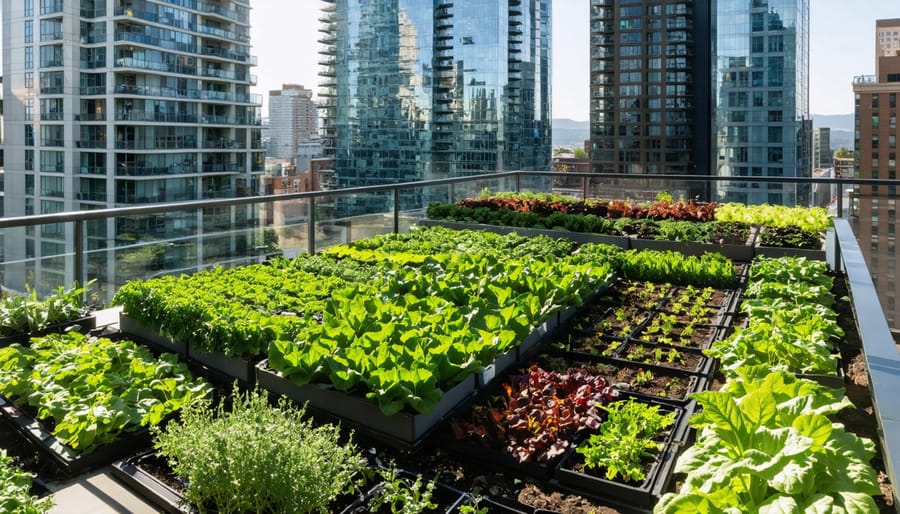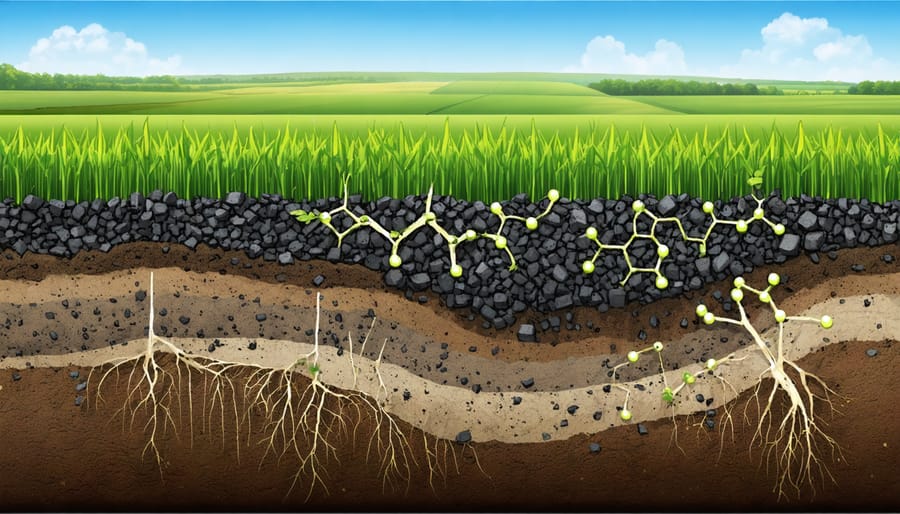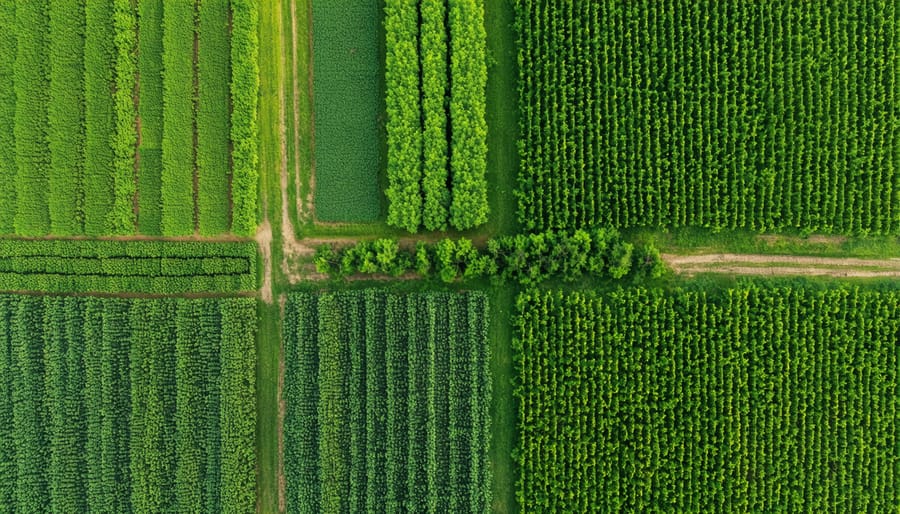Transform your farm into a balanced ecosystem by integrating natural pest control methods that work specifically in Alberta’s unique climate. Plant beneficial companion crops like marigolds and dill alongside vulnerable species to naturally repel destructive insects while attracting beneficial predators. Establish permanent hedgerows and windbreaks using native species like wolf willow and chokecherry, creating essential habitat for pest-controlling birds and beneficial insects. Rotate crops strategically on a three-to-four-year cycle, breaking pest life cycles while building soil health. Deploy targeted biological controls like parasitic wasps and predatory mites – proven effective in prairie conditions – to manage specific pest populations without disrupting the broader ecosystem. These sustainable approaches have helped Alberta farmers reduce pesticide use by up to 70% while maintaining or improving yields, demonstrating that effective pest management doesn’t require synthetic chemicals. By working with nature rather than against it, we’re building resilient agricultural systems that protect both farm productivity and environmental health.
Why Alberta Farms Are Shifting to Sustainable Pest Management
The Real Cost of Chemical Pesticides
While chemical pesticides may seem cost-effective initially, their long-term financial and environmental impacts tell a different story. Alberta farmers investing in organic farming in Alberta have reported that chemical pesticide expenses can reach $50-75 per hectare annually, not including application costs and equipment maintenance.
Beyond direct costs, chemical pesticides can lead to resistant pest populations, requiring increasingly expensive treatments. They also impact beneficial insects that naturally control pest populations, creating a costly cycle of dependency. Soil degradation from continued chemical use can reduce fertility, potentially decreasing crop yields by 15-30% over time.
Environmental costs include groundwater contamination, which affects drinking water quality and requires expensive remediation. Local studies show that chemical pesticide runoff has impacted Alberta’s watershed health, with restoration costs estimated at millions of dollars. Additionally, these substances can harm pollinators, potentially reducing crop yields and requiring farmers to pay for pollination services.
By considering these hidden costs, many farmers are finding that sustainable pest control methods offer better long-term value while protecting their land’s productivity.

Alberta’s Unique Pest Challenges
Alberta’s agricultural landscape faces unique pest challenges shaped by our distinct climate patterns and growing conditions. Our cold winters typically help control pest populations, but increasingly mild winters have led to greater pest survival rates. Common challenges include wireworms in cereal crops, flea beetles in canola, and grasshoppers in dry years.
Our region’s weather extremes create specific pest management hurdles. During wet seasons, fungal diseases and slugs become prevalent, while drought periods often trigger grasshopper outbreaks. The province’s varied topography, from prairie to parkland, means farmers must adapt their pest control strategies to local conditions.
Climate change has introduced new challenges, with some pest species extending their range northward. For example, wheat midge has become increasingly problematic in central Alberta, while new insects like the pea leaf weevil continue to expand their territory.
Understanding these regional patterns is crucial for developing effective sustainable pest management strategies. Local monitoring networks and early warning systems help farmers anticipate and prepare for potential pest outbreaks, making proactive management possible.
Proven Natural Pest Control Solutions
Biological Control Methods
Biological control methods harness nature’s own pest management systems by utilizing beneficial insects and organisms that naturally prey on crop pests. Here in Alberta, ladybugs, parasitic wasps, and predatory mites have proven particularly effective at controlling common agricultural pests like aphids, caterpillars, and spider mites.
Many Alberta farmers have found success with introducing beneficial nematodes to control root-feeding insects and grubs. These microscopic organisms work particularly well in our soil conditions and can provide season-long protection when properly established. Ground beetles and praying mantises, which are natural to our region, can be encouraged by creating suitable habitats along field edges and maintaining diverse vegetation strips.
Local success stories include the Brooks area vegetable farmers who’ve reduced pesticide use by 60% through strategic releases of predatory insects. Similarly, organic grain producers near Red Deer have effectively managed wheat midge populations by supporting parasitic wasp populations.
To establish a successful biological control program, timing is crucial. Release beneficial insects when pest populations are beginning to build, but before they reach damaging levels. Creating insectary strips with flowering plants like alfalfa and clover provides food and shelter for these helpful insects throughout the growing season.
Remember that biological control methods work best as part of an integrated pest management strategy, allowing time for natural predator populations to establish and maintain balance in your agricultural ecosystem.
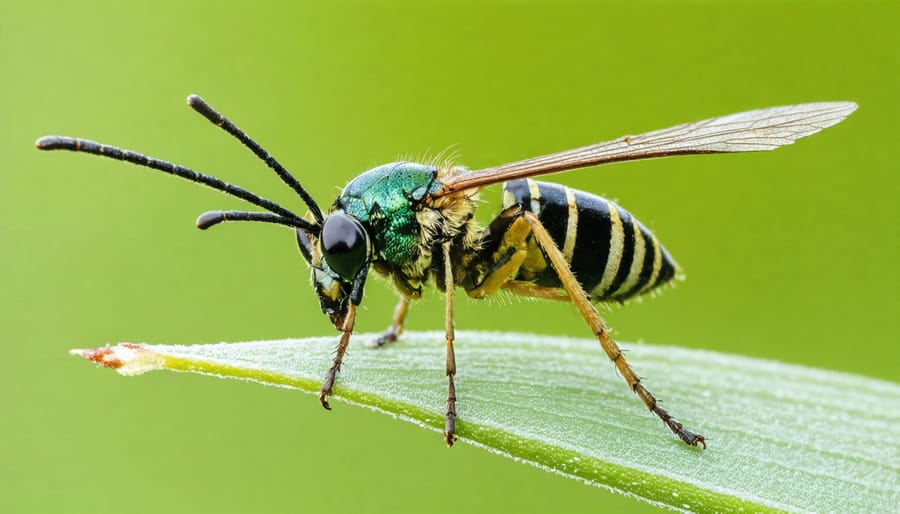
Crop Rotation and Companion Planting
Strategically rotating crops and pairing complementary plants creates a natural defense system against pests while enhancing soil biodiversity. In Alberta’s diverse growing regions, successful farmers have found that alternating between grain crops, legumes, and brassicas helps break pest cycles and reduces the need for chemical interventions.
Consider implementing a three to four-year rotation schedule, moving from heavy feeders like corn to soil-building legumes like field peas, followed by light feeders such as carrots. This practice naturally disrupts pest habitat patterns while maintaining soil health. Many Alberta farmers report significant reductions in root maggot populations when rotating cole crops with non-brassica species.
Companion planting further strengthens your pest management strategy. Plant aromatic herbs like dill and fennel alongside brassicas to deter cabbage moths. Marigolds serve as excellent companions throughout your fields, naturally repelling harmful nematodes. For greenhouse operations, incorporating nasturtiums as trap crops helps protect main crops from aphids.
Local success stories show that combining these methods with careful timing of plantings can reduce pest pressure by up to 60% in the first season. Remember to account for your specific growing zone and soil conditions when planning your rotation and companion planting schedule. Start with small trial areas to determine which combinations work best for your operation.
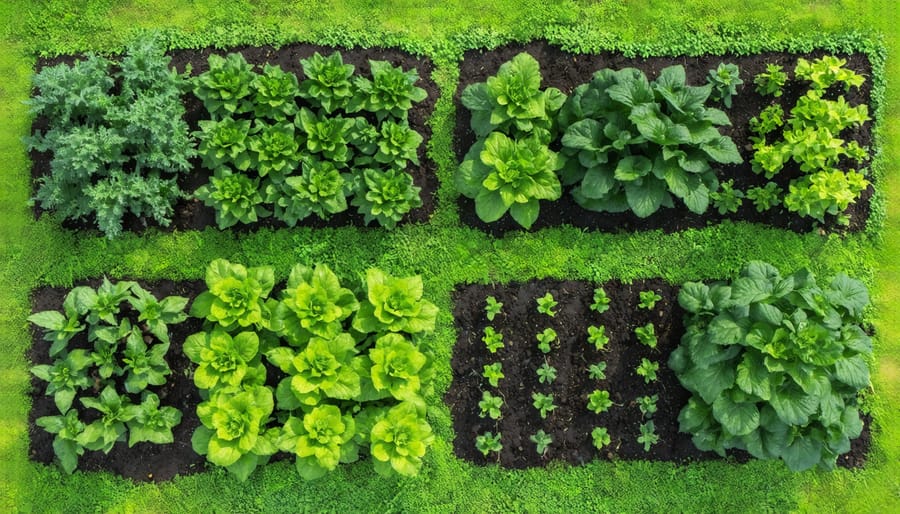
Physical and Mechanical Controls
Physical and mechanical controls offer effective, chemical-free solutions for managing pests on Alberta farms. These methods create barriers between crops and unwanted insects while preserving beneficial species that support your farm’s ecosystem.
Row covers and protective netting serve as excellent first-line defenses, especially for vegetable crops and young plants. Many Alberta farmers have found success using floating row covers during critical growing periods, which can be easily removed during pollination times. These covers are particularly effective against flea beetles and cabbage moths, common challenges in our region.
Mechanical traps come in various forms suited to different pest situations. Sticky traps work well for monitoring and controlling flying insects, while pitfall traps help manage ground-dwelling pests. For larger pests, live traps provide humane solutions that allow for relocation of animals away from crop areas.
Physical barriers like copper strips for slug control and hardware cloth for protecting tree bases from rodents have proven particularly effective in our climate. Local farmers report success with raised bed collars and strategic fencing configurations to prevent pest access while maintaining easy crop management.
Remember to regularly inspect and maintain these controls – damaged barriers or full traps won’t provide adequate protection. Many Alberta farmers combine multiple physical controls as part of their integrated pest management strategy, creating robust defense systems that work year after year.
Success Stories: Alberta Farmers Leading the Way
Central Alberta Grain Farm Case Study
The Smith family farm, located just outside of Red Deer, Alberta, demonstrates how sustainable pest control can work effectively in central Alberta’s unique climate. In 2019, after experiencing increasing pest resistance to chemical controls, third-generation farmer Sarah Smith decided to transition their 2,000-hectare grain operation to an integrated pest management approach.
The farm implemented a three-pronged strategy: crop rotation, beneficial insect habitat creation, and strategic cover cropping. They planted flowering borders around their wheat and canola fields, creating corridors for beneficial insects like ladybugs and parasitic wasps. These natural predators helped control aphid populations, which had previously caused significant crop damage.
Their rotation schedule now includes alternating cereals with pulse crops, effectively breaking pest cycles while improving soil health. Between main crops, they plant mustard as a biofumigant cover crop, naturally suppressing wireworm populations – a persistent problem in Alberta grain fields.
After three years, the Smiths reported a 60% reduction in pest-related crop losses while cutting pesticide costs by 45%. Notably, their wheat yields remained stable throughout the transition, and soil testing showed increased biological activity. Local wildlife populations, including birds and beneficial insects, have visibly increased on their property.
The success of this approach has inspired neighbouring farms to adopt similar practices, creating a growing community of sustainable farmers in the region.
Southern Alberta Market Garden Success
In the heart of Southern Alberta, the Henderson Family Farm has transformed their 15-hectare market garden operation through innovative sustainable pest control methods. Sarah Henderson, a third-generation farmer, shares how their transition from conventional pesticides to integrated pest management has enhanced both crop quality and soil health.
“We grow everything from root vegetables to leafy greens, and each crop faces unique pest challenges,” explains Henderson. “By introducing beneficial insects like ladybugs and praying mantises, we’ve successfully controlled aphid populations in our lettuce and kale crops without chemical interventions.”
The farm’s success stems from their strategic use of companion planting. Marigolds and nasturtiums border their tomato beds, naturally repelling harmful insects while attracting pollinators. They’ve also implemented trap crops, using mustard greens to draw flea beetles away from their main brassica crops.
Their innovative approach includes installing bat houses and bird boxes around the property, creating a natural pest control system that works round the clock. “The birds and bats have become our nightshift workers,” Henderson jokes, noting a significant reduction in moth and beetle populations.
The results speak for themselves: crop losses due to pest damage have decreased by 60% over three years, while their organic certification has opened new market opportunities at farmers’ markets throughout Southern Alberta. The farm now serves as a demonstration site for sustainable pest management practices in market garden operations.
Implementation Guide for Your Farm
Assessment and Planning
Before implementing any pest control strategy, it’s crucial to conduct a thorough assessment of your farm’s current situation. Start by mapping your property and identifying problem areas where pests frequently occur. Document the types of pests present, their population levels, and the extent of crop damage they cause.
Consider maintaining a detailed pest monitoring log throughout the growing season. This helps track pest patterns and their relationship with weather conditions, crop stages, and existing sustainable farming practices. For Alberta farmers, this might include monitoring for common regional pests like grasshoppers, wheat midge, or bertha armyworms.
Work with local agricultural extension agents to establish economic thresholds – the point at which pest control becomes economically necessary. This prevents unnecessary interventions and helps preserve beneficial insects. Remember to factor in your farm’s unique characteristics, such as soil type, microclimate, and neighbouring land use.
Develop your management plan by incorporating multiple control strategies. This might include crop rotation schedules, companion planting arrangements, and timing of cultural controls. Set realistic goals and establish measurable benchmarks to track your progress. Include contingency plans for extreme pest pressures and weather events, which are becoming more common in Alberta’s changing climate.
Regular plan review and adjustment are essential. Schedule quarterly assessments to evaluate the effectiveness of your strategies and make necessary modifications based on your documented observations.
Resources and Support
Alberta offers numerous resources to support farmers transitioning to sustainable pest control methods. The Alberta Agriculture and Forestry department provides free consultation services through their pest management specialists, who can assess your specific situation and recommend eco-friendly solutions.
Local agricultural extension offices across the province offer workshops and training sessions on integrated pest management throughout the growing season. These hands-on learning opportunities allow farmers to connect with experts and fellow producers while gaining practical skills.
For funding support, the Canadian Agricultural Partnership (CAP) offers cost-sharing programs specifically for sustainable agriculture initiatives. Farmers can apply for grants covering up to 50% of costs related to implementing biological pest control methods or purchasing monitoring equipment.
The Environmental Farm Plan (EFP) program provides additional financial assistance and guidance for farmers looking to enhance their environmental stewardship. Completing an EFP can unlock access to various funding streams and technical support services.
Regional pest monitoring networks, coordinated by Alberta Agriculture, help farmers stay informed about pest pressures and emerging threats. These networks provide real-time data and early warning systems, enabling proactive pest management decisions.
Connect with your local agricultural society or farmers’ association to join peer support groups focused on sustainable farming practices. These communities often share valuable experiences, resources, and innovative solutions for pest control challenges specific to your area.
Sustainable pest control is more than just an environmental choice – it’s a smart investment in the future of Alberta’s agriculture. By adopting integrated pest management strategies, supporting beneficial insects, and implementing cultural controls, we can protect our crops while preserving our soil health and biodiversity. The success stories from local farms demonstrate that sustainable methods are both effective and economically viable in our unique climate. As our agricultural community continues to grow, let’s work together to share knowledge, support one another, and build resilient farming practices. Remember, every step toward sustainable pest control, no matter how small, contributes to healthier farms, stronger yields, and a more sustainable future for Alberta agriculture. Start implementing these methods today, and become part of the growing movement toward ecological pest management.


